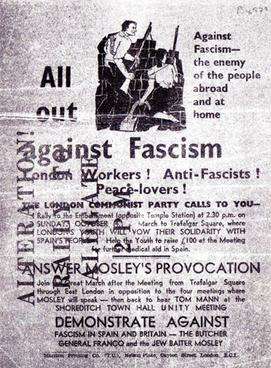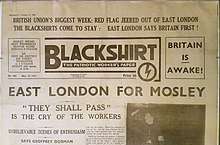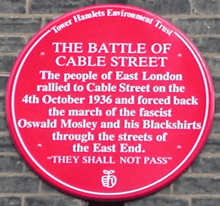Battle of Cable Street
The Battle of Cable Street was an event that took place in Cable Street and Whitechapel in the East End of London, on Sunday 4 October 1936. It was a clash between the Metropolitan Police, sent to protect a march by members of the British Union of Fascists[1] led by Oswald Mosley, and various anti-fascist demonstrators, including local anarchist, communist, Jewish and socialist groups.[2] The majority of both marchers and counter-protesters travelled into the area for this purpose.
| Battle of Cable Street | ||||
|---|---|---|---|---|
 Flyer distributed by the London Communist Party | ||||
| Date | 4 October 1936 | |||
| Location | 51.5109°N 0.0521°W | |||
| Caused by | Opposition to a fascist march through East London | |||
| Methods | Protest | |||
| Resulted in | Fascist march called off | |||
| Parties to the civil conflict | ||||
| Lead figures | ||||
| ||||
| Number | ||||
| ||||
| Casualties | ||||
| Injuries | ~175 | |||
| Arrested | ~150 | |||
Background
It had become known that the British Union of Fascists (BUF) were organising a march to take place on Sunday 4 October 1936, through the heart of the East End (an area which then had a large Jewish population).[3] Mosley planned to send thousands of marchers dressed in their Blackshirt uniform through the East End. An estimated 100,000 residents of the area petitioned then Home Secretary John Simon to ban the march because of the strong likelihood of violence. He refused, and sent a police escort in an attempt to prevent anti-fascist protesters from disrupting the march.[4]
Events
The anti-fascist groups built roadblocks in an attempt to prevent the march from taking place. The barricades were constructed near the junction with Christian Street in Stepney, towards the west end of this long street. The main confrontation took place around Gardiner's Corner in Whitechapel. An estimated 20,000 anti-fascist demonstrators turned out, and were met by 6,000–7,000 policemen (including mounted police), who attempted to clear the road to permit the march of 2,000–3,000 fascists to proceed.[5] The demonstrators fought back with sticks, rocks, chair legs and other improvised weapons. Rubbish, rotten vegetables and the contents of chamber pots were thrown at the police by women in houses along the street. After a series of running battles, Mosley agreed to abandon the march to prevent bloodshed. The BUF marchers were dispersed towards Hyde Park instead while the anti-fascists rioted with police. About 150 demonstrators were arrested, although some escaped with the help of other demonstrators. Around 175 people were injured including police, women and children.[4]
Aftermath
Many of the arrested demonstrators reported harsh treatment at the hands of the police.[6]

Between 1979 and 1983, a large mural depicting the battle was painted on the side of St George's Town Hall. This building was originally the vestry hall for the area and later the town hall of Stepney Borough Council. It stands in Cable Street, about 150 yards (140 m) west of Shadwell overground station. A red plaque in Dock Street commemorates the incident.[7]
Numerous events were planned in East London for the battle's 75th anniversary in October 2011, including music[8] and a march,[9] and the mural was once again restored. In 2016, to mark the battle's 80th anniversary, a march took place from Altab Ali Park to Cable Street.[10] The march was attended by some of those who were originally involved.[11]
The event is frequently cited by the contemporary Antifa movement.[12]
In popular culture

- The Arnold Wesker play Chicken Soup with Barley depicts an East End Jewish family on the day of the Battle of Cable Street.[13]
- The Men They Couldn't Hang's album How Green Is the Valley features a song called "Ghosts of Cable Street" that celebrates the battle.
- Terry Pratchett's novel Night Watch features a riot/battle on Cable Street against Ankh-Morpork's secret police.
- Ken Follett's novel Winter of the World, part of his Century Trilogy, features the battle.
- The Young'uns' 2017 album Strangers includes an original song, "Cable Street", telling the story of the battle.
- In EastEnders, Dr Harold Legg and Dot Branning watch a documentary about the battle on DVD and Dr Legg recounts the events of the battle, where he met his wife Judith.
- In East by Steven Berkoff, "Dad" mentions the Battle of Cable Street in his rage, referring to Sir Oswald Mosley as someone with the "right ideas".
- Heaven Shall Burn featured the song "They shall not pass" on their 2016 album Wanderer, which referred to this incident.
See also
- Battle of George Square – a riot in Glasgow in 1919 in which William Gallacher (a colleague of Phil Piratin) was involved
- Battle of Stockton – an earlier incident between BUF members and anti-fascists in Stockton-on-Tees on 10 September 1933
- Battle of South Street – an incident between BUF members and anti-fascists in Worthing on 9 October 1934
- Battle of Stepney – a gunfight that took place in 1911, a few streets away
- Christie Pits riot – a similar incident that took place in Toronto on 16 August 1933
- 6 February 1934 crisis – a similar event that took place in Paris
References
- "Cable Street: 'Solidarity stopped Mosley's fascists'". BBC News. Retrieved 13 October 2015.
- Barling, Kurt (4 October 2011). "Why remember Battle of Cable Street?". Retrieved 16 May 2018 – via www.bbc.co.uk.
- hate, HOPE not. "The Battle of Cable Street". www.cablestreet.uk. Retrieved 16 May 2018.
- Brooke, Mike (30 December 2014). "Historian Bill Fishman, witness to 1936 Battle of Cable Street, dies at 93". News. Hackney. Hackney Gazette. Archived from the original on 17 September 2016. Retrieved 28 April 2016.
- Jones, Nigel, Mosley, Haus, 2004, p. 114
- Kushner, Anthony and Valman, Nadia (2000) Remembering Cable Street: fascism and anti-fascism in British society. Vallentine Mitchell, p. 182. ISBN 0-85303-361-7
- "Battle of Cable Street - Dock Street". London Remembers. Retrieved 16 May 2018.
- Phil Katz. "Communist Party – Communist Party". Retrieved 13 October 2015.
- Cable Street 75. "Cable Street 75". Retrieved 13 October 2015.
- Brooke, Mike. "'They Shall Not Pass' message from the past for Battle of Cable Street 80th anniversary". East London Advertiser. Retrieved 3 April 2017.
- Rod McPhee (1 October 2016). "'We still haven't learned the lesson of the Battle of Cable Street 80 years on'". Daily Mirror. Retrieved 8 September 2017.
- Penny, Daniel (22 August 2017). "An Intimate History of Antifa". The New Yorker. Retrieved 26 August 2017.
- "Chicken Soup with Barley, Royal Court, London". The Independent. 9 June 2011. Retrieved 5 May 2017.
External links
- The Battle of Cable Street 80th anniversary
- News footage from the day News reel from youtube.com
- Video for the Ghosts of Cable Street by 'They Men They Couldn't Hang' set to images of the battle
- Historical article by David Rosenberg linked to the 'battle's 75th anniversary
- The Battle of Cable Street as told by the Communist Party of Britain.
- "Fascists and Police Routed at Cable Street" a personal account of the battle by a participant.
- Cable Street and the Battle of Cable Street.
- Google Earth view of the junction of Cable Street and Christian Street as it is now
- The Myth of Cable Street on the History Today website
- A police constable's account - Tom Wilson was on duty at Cable Street